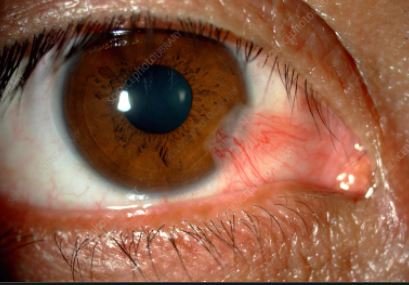A 69 y.o. female with allergies comes to the ED with "something in her eye"
what is it?
Our patient had squamous cell carcinoma of the conjunctiva with a papillomatous form.
Lesions of the conjunctiva can include benign lesions as well which are much more common than malignant lesions. Both benign and malignant are described by their growth pattern as sessile or papillomatous.
BENIGN LESIONS OF THE CONJUNCTIVA
hpv papilloma of the conjunctiva
Conjunctival papillomas are most often benign tumors which are thought to be caused by human papillomavirus in many cases. They are normally excised using a no-touch technique by handling only the adjacent, normal tissues to avoid spreading virus particles. About 30% of lesions recur. Adjunctive cryotherapy or CO2 laser are often done after surgical excision.
Sessile lesions of the conjunctiva include pterygiums and pingueculas.
A pterygium grows on to the cornea
The pterygium is commonly thought to be caused by UV light and has become known as “surfer’s” eye. It is a growth of conjunctiva on to the cornea of the eye. In contrast the pinguecula does not extend on to the cornea and is a deposition of protein.
pinguecula does not affect the cornea
SO HOW DO YOU TELL THE DIFFERENCE BETWEEN BENIGN AND MALIGNANT LESIONS OF THE CONJUNCTIVA?
It is difficult to tell the difference between benign and malignant on physical exam. It is estimated that 60% of lesions are misdiagnosed. Any of the benign lesions can later become malignant. One clue as to a malignancy is in the history; rapid growth as in our patient where the lesion progressed over two weeks. . The ultimate determinant is whether the lesion goes through the basement membrane of the conjunctiva. This defines squamous cell ca. The two useful ways to determine if a lesion is malignant are: histology (a filter paper is pressed on the lesion and cells are examined histologically) and. SS-OCT( Swept-source optical coherence tomography ) which is a method of imaging the epithelium of the conjunctiva. If there is hyper-reflective epithelium , the lesion is considered malignant.
the arrow points to the hyperreflective epithelium characteristic of cancer invasion.
The lesions most commonly found on the conjunctiva which are malignant include: squamous cell ca, melanoma and lymphoma. Our patient was treated with topical interferon and is scheduled for a visit to discuss surgical resection.
Kaliki S, Arepalli S, shields C, et al. conjunctival papilloma: features and outcomes based on age at initial examination. JAMA Ophthalmol. 2013;131:585-93.
Ramberg I, Bjerre Toft P, Georgsen J, et al. conjunctival intraepithelial neoplasia and carcinoma: distinct clinical and histological features in relation to human papilloma virus status. British Journal of Ophthalmology 2021;105:878-883.
Huang Y, huang Y-Y, Yang H, et al. Conjunctival papilloma: clinical features, outcome and factors related to recurrence. Taiwan J Ophthalmol. 2018Jan-Mar;8(1):15-18.
Elhamaky T, Elbarky A. AS-OCT guided treatment of diffuse conjunctival squamous cell carcinoma with resection amniotic membrane graft and topical mitomycin C. Clin Ophthalmol. 2019;13:2269-2278.





